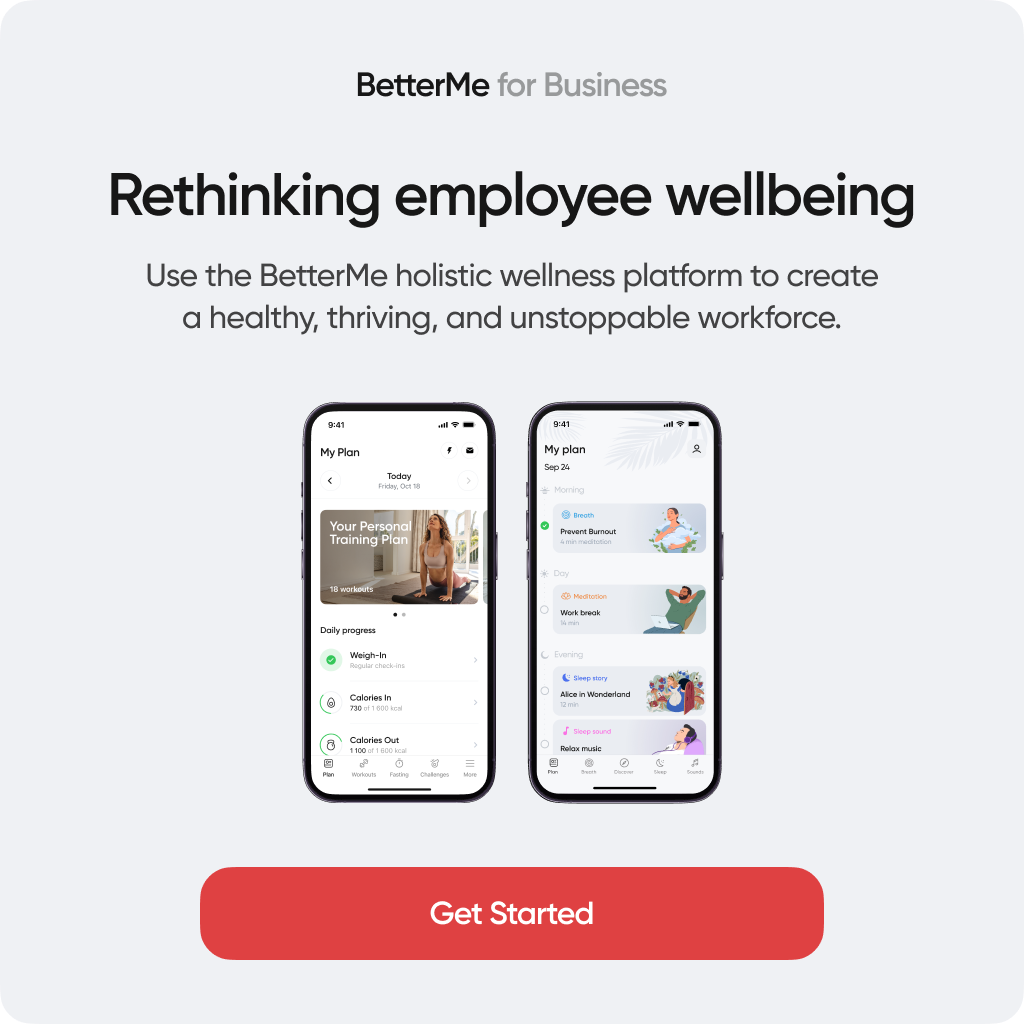The bustling office work may be excruciating for so many of us. The 9-to-5 schedule seems to be shifting for longer hours. Your workers are swamped with responsibilities doing them automatically, which gives you a less lucrative outcome. The reality here is simple: your workers are the essential asset your company depends on. If they’re sick, bored, or simply exhausted, you might as well say farewells to your possible monetary success. Luckily, there are tons of wellness programs at work promoting the emotional, physical, and mental health of your employees along with stabilizing their financial situation. This article uncovers 5 benefits of workplace wellness programs, as a content employee is your key to success.
What Is A Workplace Wellness?
Burnout at work is a common problem among thousands of workers worldwide. Why? There are many reasons, beginning with health issues up to relationships with other employees.
Thus, many employers implement workplace wellness programs, which are effective ways that boost productivity, promote health, and reduce general burnout. Additionally, employee wellness isn’t only limited to the situation inside the company as it also touches their daily life. Dietary choices, sports activities, and relationships with people, among others, are also other points that may affect endeavors at jobs.
If your employees embrace healthy lifestyles, your company, organization, or small business has a greater chance to encounter better opportunities for growth.
Despite 80% of employees stating they support their workers, only 46% of employees feel the said support (2).
Thankfully, particular workplace health and wellness programs can foster a culture of good emotional, mental, social, and physical health. They make workers more invigorating and initiative, as well as help them manage time more effectively.
What Are The 5 Components Of Wellness?
These 5 dimensions of wellness encompass your daily life with new challenges, situations, and opportunities.
Let’s take a closer look at 5 crucial aspects of personal health:
- Physical
- Emotional
- Social
- Spiritual
- Intellectual (5)
Physical Wellness
This dimension is on top of the list as your healthy body gives you the ability to complete daily tasks more easily. You can ace it by exercising, eating healthily, avoiding alcohol and drugs, and sleeping well (5). Yes, these are easier than done – but every individual needs to realize that their work accomplishments depend on their health.
Besides, physical wellness also includes checking the body: biometric assessment or ultrasound diagnostic will be a good starter for people who genuinely care about their health.
Here are some examples of wellness programs for companies that want to implement physical wellness:
- Have on-site fitness centers that are easily accessible to employees.
- Provide easy access to science-based workout and nutrition plans.
- Quit smoking programs. The “Smoking Cessation” program involves lifestyle coaching and pharmacological help for the workers.
- Provide healthy snacks and lunch in the company.
- Nap time for workers. Major companies provided special nap rooms for tired employees to grab a short nap. They return to work fresh and energetic for new challenges.
Read More: Does Chair Yoga Work? The Truth According To Wellness Experts
Emotional Wellness
Emotional wellness entails how the person can handle emotions and deal with different life events. It is important for proper functioning and of course building connections with others. It also affects how people cope with stress and challenges at work. The main signs of poor emotional wellness are lack of energy, self-harm, feeling agitated, or inability to concentrate.
It’s possible to promote emotional wellness by developing a positive mindset, managing and reducing stress, staying mindful, or contacting a therapist (9).
Here are some examples of wellness programs for companies that want to implement emotional wellness:
- Meditation sessions
- Serene yoga sessions
- Attending therapy
- Vision boards
- 30-day social media detox challenge
Social Wellness
Almost all of us yearn to be part of some group. Even introverts embrace healthy communication with others as it helps them find fruitful connections and achieve anticipated goals. Others may find it difficult to achieve social wellness, but there are quick and engaging steps you can start with. You may begin with making new connections by getting out of your solitude comfort zone, caring about others and yourself, eliminating toxic people from your life, and setting boundaries and sticking to them.
Here are some examples of wellness programs for companies that want to implement social wellness:
- Throw mingling parties for workers
- Participate in volunteering
- Take on challenges together
- Organize standups and other activities for cheer laughter
- Schedule walking meetings
- Schedule a trip to a new city or country
- Set sessions with mentors or life coaches
Spiritual Wellness
Spiritual wellness is not about trekking to church every Sunday because you’re supposed to. It entails recognizing your sense of purpose and meaning in life. Plus, it’s your ability to follow morals and ethics for a peaceful existence.
Amping up spiritual wellness in employees helps them reduce anxiety, depression, and stress; aids in personal development, reduces procrastination, and strengthens the immune system.
Here are some examples of wellness programs for companies that want to implement spiritual wellness:
- Meditation
- Journaling and brainstorming exercises
- Contemplation breaks
- Spending time in nature
Intellectual Wellness
Stay curious, creative, and critical — the 3C rule of intellectual wellness. Through intellectual wellness, you can recognize your creative abilities, utilize them – both personally and professionally – and expand your knowledge for new challenges. Your intellectual wellness highly affects your work engagement and productivity.
Managing time, improving critical thinking, studying something new whether or not connected to your professional sphere, reading books, or listening to engaging podcasts on your favorite topics are just some of the ways to enhance it (7).
Here are some examples of wellness programs for companies that want to implement intellectual wellness:
- Set reading clubs for workers
- Incorporate time-management classes
- Play problem-solving games or quizzes
- Explore ideas for the new projects
What Are The 5 Benefits Of Wellness?
Businesses can get an array of benefits from well-being and workplace wellness programs. Creating a healthier and happier workplace is the major key to growing assets.
Flip through the following list of 5 corporate wellness benefits:
- Employees get more engaged and productive. The lack of engagement and enthusiasm among workers is the consequence of work stressors. No worker will do productive work with nagging thoughts in the head. Hence, improving their mental and emotional health via special wellness programs leads to sustainable attendance and engagement in their responsibilities.
- It reduces healthcare costs. Among other workplace benefits, this point will save companies the money for healthcare costs. The chain of improvements is simple: promoting the health of the company’s workplace, makes the employees healthier. The healthier the employee, the less frequently they receive medical care – hence, saving the organization money in healthcare expenses.
- Employees have the motivation to keep working for your company. Let’s face it, we all desire to be appreciated. If your worker feels respected and gains all the opportunities to promote well-being, they will want to commit to the company for longer.
- Employees become healthier. Incorporating health and wellness in the workplace ideas helps your workers build healthy habits. An active lifestyle, good sleep, and a nutritious diet reduce the chances of many conditions that affect their work.
- They attract new talents. Promoting wellness programs for employees allow you to add them to your application list of benefits. By doing this, you’ll stand out from other companies which don’t offer such programs.
How Is Wellness Different From Health?
The concepts of health and wellness are quite different than they seem for the first time. Answer yourself: How am I feeling? And What do I do to feel that way?
The notion of health refers to the state of emotional, mental, and physical well-being (10). Shortly, health is your goal.
Wellness is the process of promoting your health by incorporating atomic habits and other activities just to feel better.
Shortly, wellness is your process of reaching that goal.
But here is one addition, wellness is your lifestyle allowing you to become the best version of yourself.
To maintain health, you need to practice wellness daily.
The importance of workplace wellness programs lies in fostering good habits in employees’ lives:
- They eat better food, therefore, reducing the risk of health conditions.
- They take gym or fitness classes, therefore, becoming more vigorous and productive.
- They take advantage of the medical checkups your company proposes, uncover potential risks, and work on them.
- They take yoga or meditation classes that evoke mindfulness and assertiveness.
- They vent to therapists about their feelings or recent fights with other employees, and figure out the best solution.
Read More: Understanding The 8 Areas Of Wellness
Why Are Wellness Goals Important?
Neglecting workplace wellness trends may lead to a lack of motivation, strength, or even layouts. Every employer needs to realize that workers are swamped with daily obligations and may need a small push for positive changes.
There are tons of versatile personalities under one roof dealing with their issues, hence, employee engagement in workplace wellness will elevate if the employer:
- Figures out the specific wellness goals and shares them with workers
- Takes part in workplace wellness programs
- Request regular feedback
Why Wellness Goals Are Essential?
- Help you build particular instructions on employee improvements
- Assist in productivity and higher attendance
- Maintain healthier communication among workers
- Shed light on possible pitfalls you should be aware of
Participating In Challenges To Promote Wellness
One of the best workplace wellness examples is participation in challenges, such as:
- 3-month yoga challenge for physical wellness
- 5-month savings challenge for financial wellness
- 1-week meditation challenge for mental and emotional health
- 2 hours per week shared hobbies or movie-watching challenge for social wellness
- 4-month new language challenge for intellectual wellness
Employers participation is crucial. Real leaders don’t only observe these challenges but actively engage in them. If employees see employers using these programs, they are more likely to be using them as well. This works perfectly during the workday when managers invite their team to take part in some activity together with them.
Why Is Workplace Wellness Important?
The benefits of workplace wellness programs make your workers happier, more productive, and more motivated to contribute to the company. Plus, well-balanced employees make businesses more profitable, therefore, attracting new talents.
Workplace wellness became especially important after Covid-19. During the pandemic, 30% of Americans demonstrated symptoms of depression, anxiety, or both (3). Daily stressors outside work affect employees, which unfortunately impairs the success of the company.
Hence, wellness programs for employees can improve the mental, emotional, and physical health of workers.
Employee wellness programs are becoming more commonplace, giving benefits to both employers and employees. Gushing about the healthcare benefits of workplace wellness can take a lot of time.
The numbers, though, show real facts of positive changes for companies and their staff.
Statistics show that:
- There are about 52% of U.S. companies that offer wellness programs.
- Every dollar that was spent on the wellness program leads to the company saving around $3.27 because of reduced healthcare costs.
- 87% of new employees consider health and wellness workplace offerings when choosing a company.
Frequently Asked Questions (FAQs)
How To Promote Workplace Wellness?
The best way to increase employee wellness is to start with an anonymous survey to specify the values and needs of your workers. Forming the wellness committee and defining goals will be the second step. Consequently, you should then learn about the right wellness resources and find the vendors for your next wellness program. Lastly, gather feedback from the workers after the end of the wellness workplace programs.
How Well Do Workplace Wellness Programs Work?
Workplace wellness day benefits both employers and their employees. Employers will likely have fewer sick days due to the programs, and more and more employees enjoy doing their work. Wellness programs promote the physical, social, emotional, intellectual, and spiritual health wellness of the employees, as well as the employer, which is an important asset of the company. The engagement of the employers in the wellness programs plays a crucial part here.
How To Increase Workplace Wellness?
It is quite a challenge to promote workplace wellness, but there is no other effective way to upgrade the productivity and loyalty of your workers than this. The top workplace wellness tips include promoting stress management strategies, implementing health challenges, like yoga, gym classes, or pilates, encouraging healthy diets by serving nutritious snacks and lunch at the company, and spending time in nature to cool down from the in-house four-wall atmosphere.
How Many Companies Have Workplace Wellness Programs?
We live in a time when most companies offer wellness programs for their workers. According to the 2019 Employer Health Benefits Survey from Kaiser Family Foundation, 84% of companies with more than 200 workers offered corporate wellness programs.
How Can A Workplace Wellness Program Help?
The workplace holistic employee program boosts the learning and personal development of the staff. As a result, workers who participate in wellness programs promote their physical health, emotional state, and creative thinking, and hone their essential problem-solving skills. They also have a chance to practice mindfulness, reduce stress levels, sleep better, and have healthier communication with other employees.
The Bottom Line
Generally, there are 5 components of wellness: physical, emotional, intellectual, social, and spiritual. These dimensions impact the productivity of the workers and the outcome of the company. Therefore, it’s important to implement top wellness programs since it is found to be an effective way to boost productivity, promote health, and reduce general burnout among your employees.
DISCLAIMER:
This article is intended for general informational purposes only and does not serve to address individual circumstances. It is not a substitute for professional advice or help and should not be relied on for making any kind of decision-making. Any action taken as a direct or indirect result of the information in this article is entirely at your own risk and is your sole responsibility.
BetterMe, its content staff, and its medical advisors accept no responsibility for inaccuracies, errors, misstatements, inconsistencies, or omissions and specifically disclaim any liability, loss or risk, personal, professional or otherwise, which may be incurred as a consequence, directly or indirectly, of the use and/or application of any content.
You should always seek the advice of your physician or other qualified health provider with any questions you may have regarding a medical condition or your specific situation. Never disregard professional medical advice or delay seeking it because of BetterMe content. If you suspect or think you may have a medical emergency, call your doctor.
SOURCES:
- 2019 Employer Health Benefits Survey (2019, kff.org)
- Accelerating the journey to HR 3.0 (ibm.com)
- Anxiety and Depression (2023, cdc.gov)
- Challenge 2013: Linking Employee Wellness, Morale And The Bottom-Line (2013, forbes.com)
- Dimensions of Wellness (rwu.edu)
- Financial Impact on Health Promotion Programs: A Comprehensive Review of the Literature (2001, wellsteps.com)
- Intellectual Wellness (unh.edu)
- Percentage of employers in the U.S. that offered select wellness programs and events as of 2020 (2020, statista.com)
- What is emotional health and well-being? (2023, medicalnewstoday.com)
- What is good health? (2023, medicalnewstoday.com)













